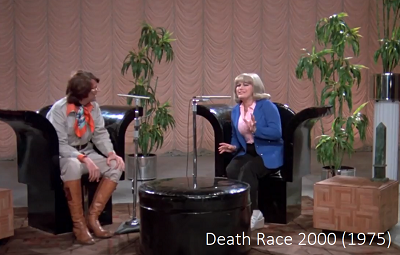
Along with Rollerball, Death Race 2000 is the other formative film of the Rollerwave aesthetic. It and Rollerball are really two sides of the same coin, and they share a lot in common- both being set in the 21st century, both being released the same year, and both dealing with an extremely dangerous sport that is used by an authoritarian government to placate the masses during a period of civic unrest.
The key difference with Death Race 2000 is in presentation. I love this movie, it’s gaudy and self-aware, sometimes to the point of farce. Whereas Rollerball is bleak and heavy-handed, Death Race 2000, directed by cult cinema king Roger Corman, revels in the absurdity of its concept- a national cross-country race, held annually, where there are virtually no rules and points are awarded to whoever can mow down the most civilians during their journey from the East Coast to the West Coast.
With the iconic tagline “In the year 2000, hit and run driving is no longer a felony. It’s the national sport!” Death Race 2000 does not concern itself with the logistics of the hypothetical world it presents- why any society would promote such a ludicrous pastime, how hit-and-run has been accepted as a way of life, or why anyone would choose to walk out in the open during the day of the publicly announced event rather than just staying home. Unlike rollerball, which is theoretically a sport which can be played without any of its participants dying, the titular Death Race here is a plothole-laden carnival of madness, of freakish exhilaration and bloodsport.
Like Rollerball, Death Race 2000 contains many scenes wherein the aesthetic of Rollerwave is on full display- particularly in the character of Junior Bruce, the manic wild-eyed TV announcer who has been adopted canonically as a sort of mascot for Rollerwave as a whole. His fashion choices are excessive to say the least, consisting of tinted aviator sunglasses, a tan jacket, leather safari boots, and a blazing orange kerchief.
The film follows Frankenstein (David Carradine), a well-known and respected driver of malleable identity with plans to overthrow the system and end the spectacle, using his reputation as a weapon against the state that crafted his image in much the same way Jonathan from Rollerball does. Along the way, he and his navigator, Annie, experience a turbulent and poignant romantic subplot. The gender dynamics between the drivers and their navigators are a central theme of the film, as well as the societal mores and expectations of the year 2000, which appear entirely foreign to the people of 1975.
The film is also notable for one of the earliest roles of Sylvester Stallone, here playing Machine Gun Joe Viterbo, a full year prior to his breakthrough as Rocky Balboa. Machine Gun Joe is a formidable secondary antagonist to Carradine’s Frankenstein- ruthless, power-hungry, and brutish. He appears seldom, but during his appearances leaves an impression on the viewer.
The film’s cult status means that it is in fact part of a much larger franchise, consisting of the original 1975 film, the “Death Race” trilogy directed by video game schlock pioneer Paul W.S. Anderson and Roel Reine, and the much more faithful sequel with Roger Corman returning to the helm as director, Death Race 2050. Of all these films, however, only Death Race 2000 truly captures the Rollerwave aesthetic in all its glory.
I’ll be honest here and say that Death Race 2000 is not a film for everyone. Same may find it excessively cartoonish, some may find Carradine boring while others may find the film’s gratuitous spectacle too abrasive. For those who have seen it, however, and those in the Rollerwave community, it remains a fascinating vision into a world that could have been.